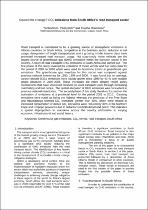JavaScript is disabled for your browser. Some features of this site may not work without it.
- ResearchSpace
- →
- Research Publications/Outputs
- →
- Conference Publications
- →
- View Item
| dc.contributor.author |
Padayachi, YR

|
|
| dc.contributor.author |
Thambiran, Tirusha

|
|
| dc.date.accessioned | 2012-11-14T07:16:56Z | |
| dc.date.available | 2012-11-14T07:16:56Z | |
| dc.date.issued | 2012-10 | |
| dc.identifier.citation | Padayachi, Y.R. and Thambiran, T. Geared for change? CO2 emissions from South Africa’s road transport sector. National Association for Clean Air: Annual Conference Proceedings, Rustenburg, 31 October - 2 November 2012 | en_US |
| dc.identifier.uri | http://hdl.handle.net/10204/6310 | |
| dc.description | National Association for Clean Air: Annual Conference Proceedings, Rustenburg, 31 October - 2 November 2012 | en_US |
| dc.description.abstract | Road transport is considered to be a growing source of atmospheric emissions in African countries. In South Africa, competition in the business sector, reduction in rail usage, deregulation of freight transportation and a growing middle income class have promoted increased road transport usage. Not surprisingly motor vehicles are the largest source of greenhouse gas (GHG) emissions within the transport sector in the country. A study of road transport GHG emissions in South Africa was carried out. The first phase of this study involved the collection of motor vehicle and fuel sales data for the period of 2001 to 2010 which were used to determine trends in greenhouse gas emissions. The greenhouse gas inventory for this sector was compared against previous national inventories for 1990, 1994 and 2000. It was found that on average, carbon dioxide (CO2) emissions have rapidly grown since 1990 by 43 % with notable peaks observed in 2007-2008. These increases are noted despite recent policy mechanisms that have increased pressure on road transport users through increasing road tolling and fuel prices. The spatial allocation of GHG emissions was not evident in previous national inventories. The second phase of this study therefore focused on the estimation of emissions at a provincial level for the period 2001 to 2010. Gauteng emissions were noted as being the highest, whereas the provinces of the Free State and Mpumalanga showed CO2 increases greater than 30%, which were related to increased consumption of diesel. CO2 emissions were reduced by 30% in the Northern Cape and Limpopo provinces due to reductions in both diesel and petrol. This indicates a spatial disproportion in emissions across the country attributable to varying economic, infrastructural and social factors. | en_US |
| dc.language.iso | en | en_US |
| dc.relation.ispartofseries | Workflow;9814 | |
| dc.subject | Road transport | en_US |
| dc.subject | Atmospheric emissions | en_US |
| dc.subject | South African atmospheric emissions | en_US |
| dc.subject | Greenhouse gas | en_US |
| dc.subject | CO2 | en_US |
| dc.subject | Carbon dioxide | en_US |
| dc.title | Geared for change? CO2 emissions from South Africa’s road transport sector | en_US |
| dc.type | Conference Presentation | en_US |
| dc.identifier.apacitation | Padayachi, Y., & Thambiran, T. (2012). Geared for change? CO2 emissions from South Africa’s road transport sector. http://hdl.handle.net/10204/6310 | en_ZA |
| dc.identifier.chicagocitation | Padayachi, YR, and Tirusha Thambiran. "Geared for change? CO2 emissions from South Africa’s road transport sector." (2012): http://hdl.handle.net/10204/6310 | en_ZA |
| dc.identifier.vancouvercitation | Padayachi Y, Thambiran T, Geared for change? CO2 emissions from South Africa’s road transport sector; 2012. http://hdl.handle.net/10204/6310 . | en_ZA |
| dc.identifier.ris | TY - Conference Presentation AU - Padayachi, YR AU - Thambiran, Tirusha AB - Road transport is considered to be a growing source of atmospheric emissions in African countries. In South Africa, competition in the business sector, reduction in rail usage, deregulation of freight transportation and a growing middle income class have promoted increased road transport usage. Not surprisingly motor vehicles are the largest source of greenhouse gas (GHG) emissions within the transport sector in the country. A study of road transport GHG emissions in South Africa was carried out. The first phase of this study involved the collection of motor vehicle and fuel sales data for the period of 2001 to 2010 which were used to determine trends in greenhouse gas emissions. The greenhouse gas inventory for this sector was compared against previous national inventories for 1990, 1994 and 2000. It was found that on average, carbon dioxide (CO2) emissions have rapidly grown since 1990 by 43 % with notable peaks observed in 2007-2008. These increases are noted despite recent policy mechanisms that have increased pressure on road transport users through increasing road tolling and fuel prices. The spatial allocation of GHG emissions was not evident in previous national inventories. The second phase of this study therefore focused on the estimation of emissions at a provincial level for the period 2001 to 2010. Gauteng emissions were noted as being the highest, whereas the provinces of the Free State and Mpumalanga showed CO2 increases greater than 30%, which were related to increased consumption of diesel. CO2 emissions were reduced by 30% in the Northern Cape and Limpopo provinces due to reductions in both diesel and petrol. This indicates a spatial disproportion in emissions across the country attributable to varying economic, infrastructural and social factors. DA - 2012-10 DB - ResearchSpace DP - CSIR KW - Road transport KW - Atmospheric emissions KW - South African atmospheric emissions KW - Greenhouse gas KW - CO2 KW - Carbon dioxide LK - https://researchspace.csir.co.za PY - 2012 T1 - Geared for change? CO2 emissions from South Africa’s road transport sector TI - Geared for change? CO2 emissions from South Africa’s road transport sector UR - http://hdl.handle.net/10204/6310 ER - | en_ZA |






